
- Kivy Tutorial
- Kivy - Home
- Kivy Basics
- Kivy - Getting Started
- Kivy - Installation
- Kivy - Architecture
- Kivy - File Syntax
- Kivy - Applications
- Kivy - Hello World
- Kivy - App Life Cycle
- Kivy - Events
- Kivy - Properties
- Kivy - Inputs
- Kivy - Behaviors
- Kivy Buttons
- Kivy - Buttons
- Kivy - Button Events
- Kivy - Button Colors
- Kivy - Button Size
- Kivy - Button Position
- Kivy - Round Buttons
- Kivy - Disabled Buttons
- Kivy - Image Button
- Kivy Widgets
- Kivy - Widgets
- Kivy - Label
- Kivy - Text Input
- Kivy - Canvas
- Kivy - Line
- Kivy - Checkbox
- Kivy - Dropdown List
- Kivy - Windows
- Kivy - ScrollView
- Kivy - Carousel
- Kivy - Slider
- Kivy - Images
- Kivy - Popup
- Kivy - Switch
- Kivy - Spinner
- Kivy - Splitter
- Kivy - Progress Bar
- Kivy - Bubble
- Kivy - Tabbed Panel
- Kivy - Scatter
- Kivy - Accordion
- Kivy - File Chooser
- Kivy - Color Picker
- Kivy - Code Input
- Kivy - Modal View
- Kivy - Toggle Button
- Kivy - Camera
- Kivy - Tree View
- Kivy - reStructuredText
- Kivy - Action Bar
- Kivy - Video Player
- Kivy - Stencil View
- Kivy - VKeyboard
- Kivy - Touch Ripple
- Kivy - Audio
- Kivy - Videos
- Kivy - Spelling
- Kivy - Effects
- Kivy - Input Recorder
- Kivy - OpenGL
- Kivy - Text
- Kivy - Text Markup
- Kivy - Settings
- Kivy Layouts
- Kivy - Layouts
- Kivy - Float Layout
- Kivy - Grid Layouts
- Kivy - Box Layouts
- Kivy - Stack Layout
- Kivy - Anchor Layout
- Kivy - Relative Layout
- Kivy - Page Layout
- Kivy - Recycle Layout
- Kivy - Layouts in Layouts
- Kivy Advanced Concepts
- Kivy - Configuration Object
- Kivy - Atlas
- Kivy - Data Loader
- Kivy - Cache Manager
- Kivy - Console
- Kivy - Animation
- Kivy - Multistroke
- Kivy - Clock
- Kivy - SVGs
- Kivy - UrlRequest
- Kivy - Clipboard
- Kivy - Factory
- Kivy - Gesture
- Kivy - Language
- Kivy - Graphics
- Kivy - Drawing
- Kivy - Packaging
- Kivy - Garden
- Kivy - Storage
- Kivy - Vector
- Kivy - Utils
- Kivy - Inspector
- Kivy - Tools
- Kivy - Logger
- Kivy - Framebuffer
- Kivy Applications and Projects
- Kivy - Drawing App
- Kivy - Calculator App
- Kivy - Stopwatch App
- Kivy - Camera Handling
- Kivy - Image Viewer
- Kivy - Bezier
- Kivy - Canvas Stress
- Kivy - Circle Drawing
- Kivy - Widget Animation
- Kivy - Miscellaneous
- Kivy Useful Resources
- Kivy - Quick Guide
- Kivy - Useful Resources
- Kivy - Discussion
Kivy - Drawing
All the GUI widgets in Kivy library have a Canvas property. Canvas is a place used for drawing various objects such as rectangle, ellipse, etc. It must be noted that Kivy doesn't have a separate Canvas widget for drawing shapes. Canvases of all widgets share a common coordinate space.
In Kivy, drawing is done on a Canvas related to any widget, with vertex instructions and context instructions.
Vertex instructions − Instructions used to draw basic geometric shapes like lines, rectangles, ellipses, etc. are called vertex instructions.
Context instructions − These instructions don't draw anything but manipulate the whole coordinate space, so to add colors to it, rotate, translate and scale it.
Vertex Instructions
These instructions are added to the Canvas in the form of different vertex objects. The vertex classes are defined in kivy.graphics.vertex_instructions module. As mentioned above, the drawing instructions are added to the context of a Canvas.
with self.canvas: vertex(**args)
The vertex_instructions module includes the following classes −
Bezier
BorderImage
Ellipse
Line
Mesh
Point
Quad
Rectangle
RoundedRectangle
SmoothLine
Triangle
Bezier
A Bezier curve is weighted by some control points, that we include within the instruction. In Kivy, Bezier is a vertex canvas instruction that draws this curve from a set of points given to the Beizer constructor as a parameter.
from kivy.graphics import Beizer with self.canvas: Beizer(**args)
Parameters
Following parameters are defined in the Beizer class −
points − List of points in the format (x1, y1, x2, y2…)
loop − bool, defaults to False, Set the bezier curve to join the last point to the first.
segments − int, defaults to 180. Define how many segments are needed for drawing the curve. More number of segments results in smoother drawing.
dash_length − Length of a segment (if dashed), defaults to 1.
dash_offset − Distance between the end of a segment and the start of the next one, defaults to 0. Changing this makes it dashed.
Example
self.w=Widget()
with self.w.canvas:
Color(0,1,1,1)
Bezier(
points=[700,400,450,300,300,350,350, 200,200,100,150,10],
segments=20
)
Color(1,1,0,1)
Point(
points =[700,400,450,300,300,350,350, 200,200,100,150,10],
pointsize= 3
)
Output
It will produce the following output window −
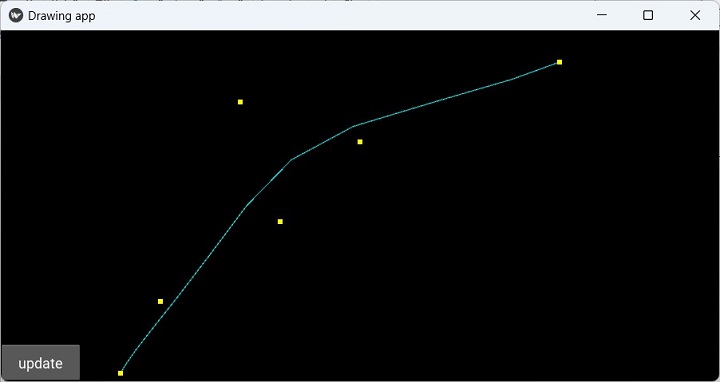
The points are shown here for reference.
Ellipse
In Kivy framework, Ellipse is a vertex instruction. Depending on the segments required, it can display a polygon, a rectangle or an arc. If the width and height parameters are equal, the result is a circle.
from kivy.graphics import Ellipse with self.canvas: Ellipse(**args)
Parameters
Following parameters are defined in the Ellipse class −
pos − the two element tuple giving the X and Y coordinate values of the center of the ellipse.
size − the two element tuple defining the width and height of ellipse in pixels.
angle_start − float, defaults to 0.0 specifies the starting angle, in degrees.
angle_end − float, defaults to 360.0 specifies the ending angle, in degrees.
segments − The number of segments of the ellipse. The ellipse drawing will be smoother if you have many segments. Use this property to create polygons with 3 or more sides. Values smaller than 3 will not be represented.
Example
self.w=Widget() with self.w.canvas: Color(0.5, .2, 0.4, 1) d = 250 Ellipse(pos=(360,200), size=(d+75, d))
Output
It will produce the following output window −
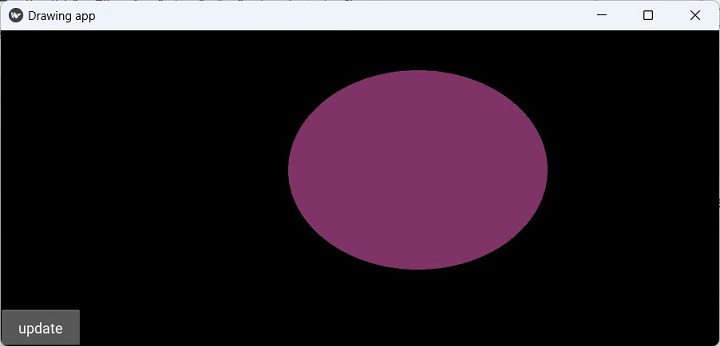
Rectangle
This vertex instruction draws a rectangle on the canvas, based on the position and dimensions given as parameters.
from kivy.graphics import Rectangle with self.canvas: Rectangle(**args)
Parameters
Following parameters are defined in the Rectangle class −
pos − list of integers, specifying Position of the rectangle, in the format (x, y).
size − list of integers, Size of the rectangle, in the format (width, height).
Drawing a rectangle filled with a certain color is the recommended way of providing background to a label.
Example
def build(self):
widget = Widget()
with widget.canvas:
Color(0, 0, 1, 1)
Rectangle(
pos=(50, 300), size_hint=(None, None),
size=(300, 200)
)
lbl = Label(
text='Hello World', font_size=24,
pos=(Window.width / 2, 300), size=(200, 200),
color=(0, 0, 1, 1)
)
with lbl.canvas.before:
Color(1, 1, 0)
Rectangle(pos=lbl.pos, size=lbl.size)
widget.add_widget(lbl)
return widget
Output
It will produce the following output window −
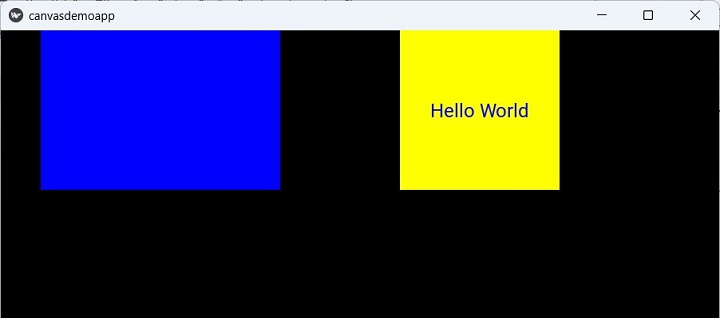
It may be noted that a Quad is a quadrilateral, a polygon with four vertices and need not be a rectangle. Similarly, a round rectangle is a rectangle with rounded vertices.
Line
In Kivy graphics, Line is a basic vertex instruction. The points property of Line object constructor has x and y coordinates of successive points. Kivy draws a line connecting the points successively.
from kivy.graphics import Line with self.canvas: Line(**args)
Parameters
Following parameters are defined in the Line class −
points − list of points in the format (x1, y1, x2, y2…)
dash_length − int Length of a segment (if dashed), defaults to 1.
dash_offset − Offset between the end of a segment and the beginning of the next one, defaults to 0. Changing this makes it dashed.
dashes − list of ints in the format [ON length, offset, ON length, offset, …]. E.g. [2,4,1,6,8,2] would create a line with the first dash length 2 then an offset of 4 then a dash length of 1 then an offset of 6 and so on.
width − float - defines the Width of the line, defaults to 1.0.
Example
def build(self):
box = BoxLayout(orientation='vertical')
self.w = Widget()
with self.w.canvas:
Color(1, 0, 0, 1)
Line(
points=[700, 400, 450, 300, 300, 350, 350, 200, 200, 100, 150, 10],
width=4
)
box.add_widget(self.w)
return box
Output
It will produce the following output window −
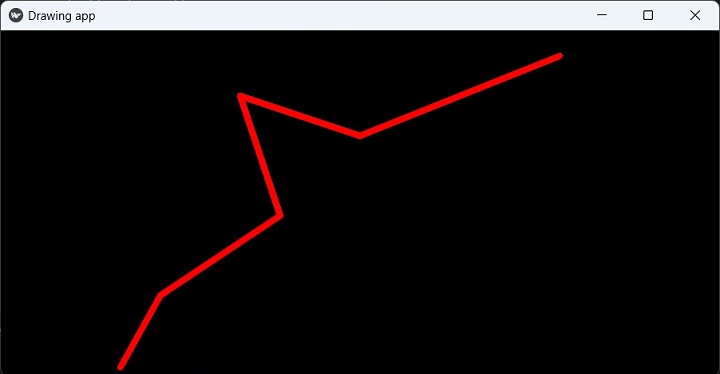
The Line class also has the properties bezier, ellipse, circle, rectangle with which the line points are used to draw respective shapes.
Triangle
With this vertex instruction, Kivy uses the points list to draw a triangle.
from kivy.graphics import Triangle with self.canvas: Triangle(**args)
The points property is a list of x an y coordinates of three vertices of the triangle in the format (x1, y1, x2, y2, x3, y3).
Example
self.w=Widget() with self.w.canvas: Color(1,1,1,1) self.triangle = Triangle(points=[100,100, 300,300, 500,100])
Output
It will produce the following output window −
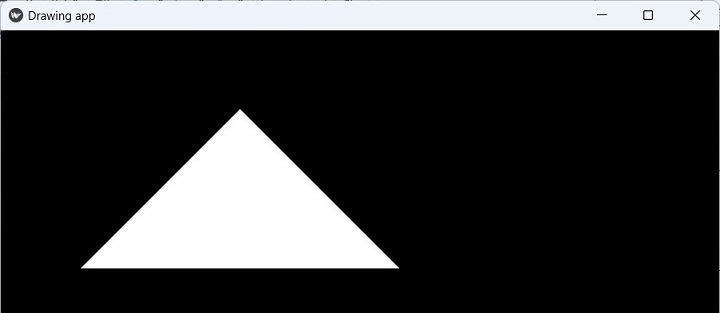
Updating a Drawing
It must be noted that the list attributes of all the graphics instruction classes (e.g. Triangle.points, Mesh.indices etc.) are not Kivy properties but Python properties. so, modifying this list won't update the drawing. It will be updated only when the list object itself is changed and not when list values are modified.
Let us change the vertex of the above rectangle by changing the point (300,300) to (400,300). We add a button to the above layout and bind it with a update method.
Example
Here is the complete code −
from kivy.app import App
from kivy.uix.button import Button
from kivy.uix.widget import Widget
from kivy.uix.boxlayout import BoxLayout
from kivy.graphics import *
from kivy.properties import ObjectProperty
from kivy.core.window import Window
Window.size = (720, 400)
class mytriangleapp(App):
triangle = ObjectProperty(None)
title = "Drawing app"
def updating(self, *args):
self.triangle.points[3] = 400
self.triangle.points = self.triangle.points
def build(self):
box = BoxLayout(orientation='vertical')
self.w = Widget()
with self.w.canvas:
Color(1, 1, 1, 1)
self.triangle = Triangle(points=[100, 100, 300, 300, 500, 100])
self.b1 = Button(
text='update', on_press=self.updating,
size_hint=(None, .1)
)
box.add_widget(self.w)
box.add_widget(self.b1)
return box
mytriangleapp().run()
Output
When the above program is executed, we see a triangle and a button. When the button is clicked, the "triangle.points" list is updated also updating the triangle drawing.
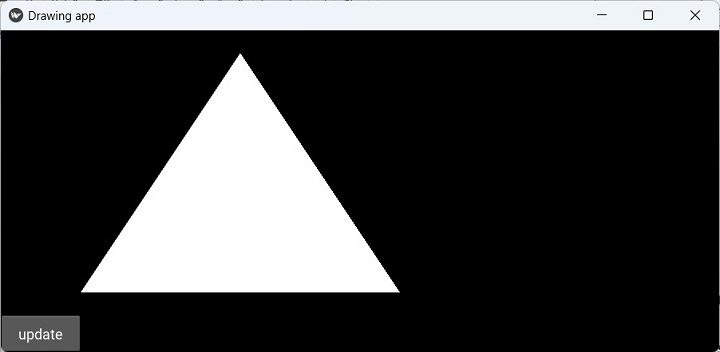
To Continue Learning Please Login